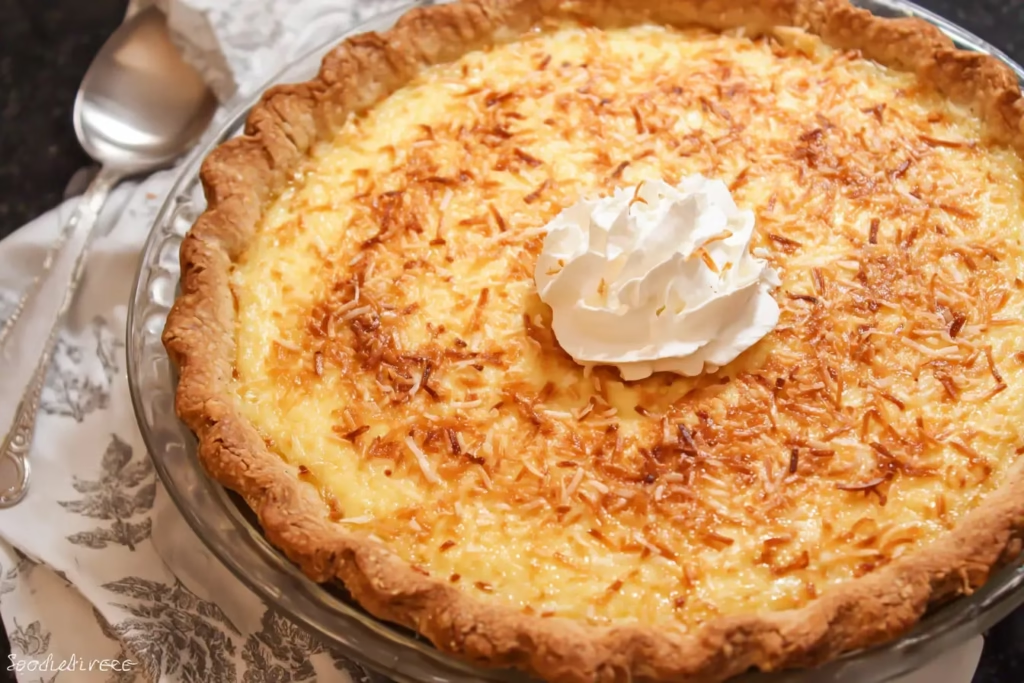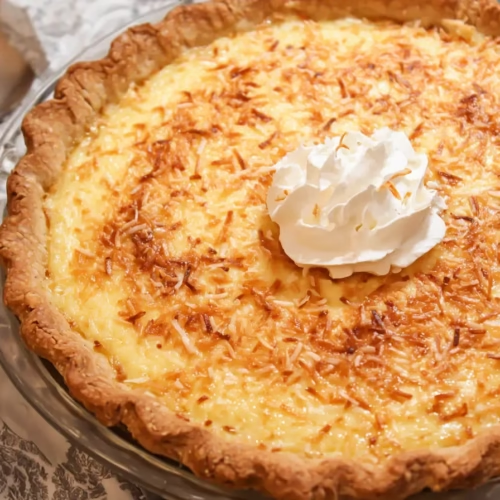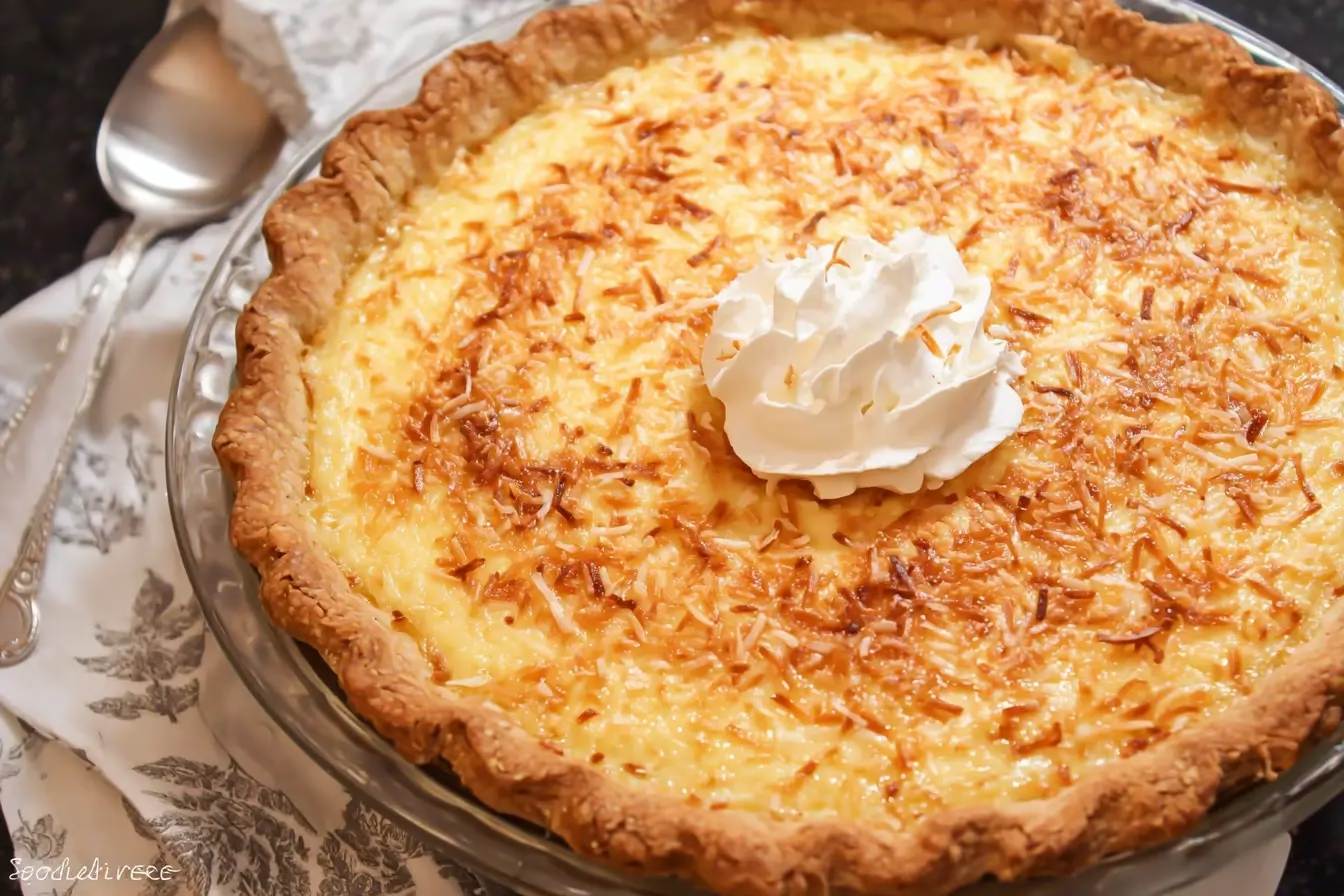Some desserts feel like they’ve been passed down through generations, carrying both flavor and memory in every bite. Coconut Custard Pie is one of those treasures—a simple but rich pie that tastes like home. With its flaky crust, creamy custard filling, and tropical coconut notes, it’s the kind of dessert that can turn an ordinary evening into a special occasion.
This pie isn’t fussy. You don’t need fancy equipment or a pastry degree—just a handful of ingredients and a little patience while it bakes and chills. Whether you’re serving it at Sunday dinner, bringing it to a potluck, or setting it on the holiday table alongside pumpkin and pecan pies, Coconut Custard Pie always earns a spot in the spotlight.
Let’s dive into what makes this pie so irresistible, how you can tweak it to fit your taste, and step-by-step instructions to bake your own from scratch.


Coconut Custard Pie
Ingredients
- 1 9-inch pie crust shell homemade or store-bought
- 3 large eggs whisked
- ¾ cup granulated sugar
- ¼ teaspoon salt
- 1 teaspoon coconut extract or substitute with vanilla extract
- 1 cup whole milk or evaporated milk
- 1 cup coconut milk full-fat, well-mixed
- 1 cup shredded sweetened coconut or use unsweetened for less sweetness
- whipped cream for topping, optional
- toasted coconut optional garnish
Instructions
- Preheat the oven to 450°F (232°C).
- Roll out pie crust and fit into a 9-inch pie plate. Trim and crimp edges, then refrigerate while preparing the filling.
- In a large bowl, whisk the eggs until frothy. Gradually add sugar and salt, mixing until smooth.
- Stir in coconut extract, whole milk, and coconut milk. Whisk until combined.
- Fold in shredded coconut until evenly distributed.
- Pour the custard mixture into the chilled pie shell.
- Bake at 450°F for 20 minutes. Reduce heat to 350°F (177°C), cover crust edges with foil, and bake for another 20–25 minutes.
- Check for doneness by inserting a toothpick near the center; it should come out mostly clean, with a slight jiggle in the center.
- Cool pie at room temperature, then refrigerate for at least 4 hours or overnight to fully set.
- Serve chilled with whipped cream and a sprinkle of toasted coconut, if desired.
Notes
Ingredients & Substitutions
Here’s what you’ll need (and how you can adjust if necessary):
- Pie Crust Shell: A standard 9-inch pie crust works best. You can use a homemade crust for that rustic, buttery flavor, or grab a store-bought one if you’re short on time. Gluten-free crusts also bake up beautifully with this recipe.
- Eggs: Three large eggs provide structure to the custard. Always whisk them well for a smooth filling.
- Sugar: White granulated sugar is classic, but you can experiment with light brown sugar for a deeper caramelized sweetness.
- Salt: Just a pinch to balance the sweetness.
- Coconut Extract: This intensifies the flavor. If you don’t have it, vanilla extract will give a softer flavor profile.
- Whole Milk: Adds richness and creaminess. Low-fat milk will make the custard lighter but less decadent.
- Coconut Milk: This is where the tropical depth comes from. Use full-fat, well-mixed coconut milk for the best texture.
- Shredded Sweetened Coconut: The hero ingredient that makes the custard chewy and flavorful. Unsweetened coconut can be used if you prefer less sweetness.
- Whipped Cream: Optional, but highly recommended as a topping. It lightens the richness with a fluffy finish.

Step-by-Step: How to Make Coconut Custard Pie
1. Preheat the oven
Set your oven to 450°F (232°C). Starting hot helps set the custard quickly and prevents a soggy crust.
2. Prepare the crust
Roll the dough into an 11- to 12-inch circle. Place it carefully into a 9-inch pie plate, trimming and crimping the edges. Refrigerate while you prepare the filling. A chilled crust bakes flakier and holds up to the custard.
3. Make the filling
In a large bowl, whisk the eggs until frothy. Gradually add sugar and salt, mixing until smooth. Stir in coconut extract, whole milk, and coconut milk. Finally, whisk in the shredded coconut until fully incorporated.
4. Assemble
Pour the custard filling into the chilled pie shell.
5. Bake hot, then low
Bake at 450°F for 20 minutes. Then reduce the heat to 350°F (177°C). Cover the crust edges with foil to avoid burning and bake another 20–25 minutes.
6. Check for doneness
The custard should be mostly set but slightly jiggly in the center. Insert a toothpick near the middle; it should come out mostly clean.
7. Cool & Chill
Let the pie cool at room temperature, then refrigerate for at least 4 hours (overnight is even better). This step is crucial—chilling allows the custard to firm up into creamy perfection.
8. Serve
Top slices with whipped cream and maybe a sprinkle of toasted coconut.
Toppings & Variations
- Toasted Coconut Garnish: Lightly toast shredded coconut in a dry skillet until golden and sprinkle on top before serving.
- Chocolate Drizzle: Add a thin drizzle of melted chocolate for a Mounds-bar-inspired flavor.
- Pineapple Twist: Stir in ½ cup crushed pineapple for a Piña Colada-style pie (see also Pineapple Christmas Balls).
- Nutty Crunch: Sprinkle chopped pecans or macadamias over the whipped cream topping for extra texture.
- Mini Pies: Bake in muffin tins with individual crusts for bite-sized party desserts.
How to Store Coconut Custard Pie
- Refrigerator: Store covered in the fridge for up to 4 days.
- Freezer: Wrap slices tightly in plastic wrap and foil; freeze for up to 2 months. Thaw overnight in the fridge before serving.
Health Benefits of Coconut
Besides its delicious flavor, coconut offers a few health perks. It’s rich in fiber and contains medium-chain triglycerides (MCTs), which may support metabolism and energy (learn more from Healthline’s coconut nutrition guide).
Of course, this pie isn’t exactly a health food—it’s dessert after all! But knowing coconut adds a little extra goodness makes each slice even more satisfying.

People Also Ask (PAA)
1. Can I make Coconut Custard Pie ahead of time?
Yes! This pie actually improves with chilling time. Make it the day before and let it set overnight in the fridge. The flavors deepen, and the texture becomes even creamier.
2. What’s the difference between Coconut Cream Pie and Coconut Custard Pie?
Coconut Cream Pie uses a stovetop-cooked pudding filling that’s topped with whipped cream, while Coconut Custard Pie is baked with the custard inside the crust. The custard version is denser and more traditional.
3. Can I use evaporated milk instead of whole milk?
Absolutely. Evaporated milk makes the pie slightly richer and gives a smoother custard texture. Just keep the coconut milk in the mix for that signature flavor.
4. How do I prevent my custard from curdling?
Don’t skip the temperature change! Baking hot first and then lowering the heat keeps the custard stable. Also, avoid overbaking—take it out while it’s still a little wobbly in the center.
5. Is this pie gluten-free?
The filling is naturally gluten-free. To make the entire dessert gluten-free, simply use a gluten-free pie crust.
6. Can I use unsweetened coconut?
Yes, but you may want to slightly increase the sugar to balance the flavor. Unsweetened coconut will give a less sweet but nuttier result.
Bringing It All Together
Coconut Custard Pie is one of those desserts that feels both familiar and a little exotic. It takes the comfort of a classic custard pie and adds the tropical sweetness of coconut, creating something timeless yet unique. It’s as welcome at a backyard barbecue as it is on a Thanksgiving table.
Once you master the basic recipe, you can riff with variations, toppings, and twists. Pair it with a hot cup of coffee or serve it chilled with fresh fruit—it never disappoints.
Want to explore more coconut-inspired desserts? Try my No-Bake Coconut Pecan Praline Cookies, Coconut Toffee Chocolate Chip Cookie Bars, or dive into my full Coconut Candy Guide.
And don’t forget to share your Coconut Custard Pie creations on Facebook and Pinterest. I’d love to see how yours turns out!

